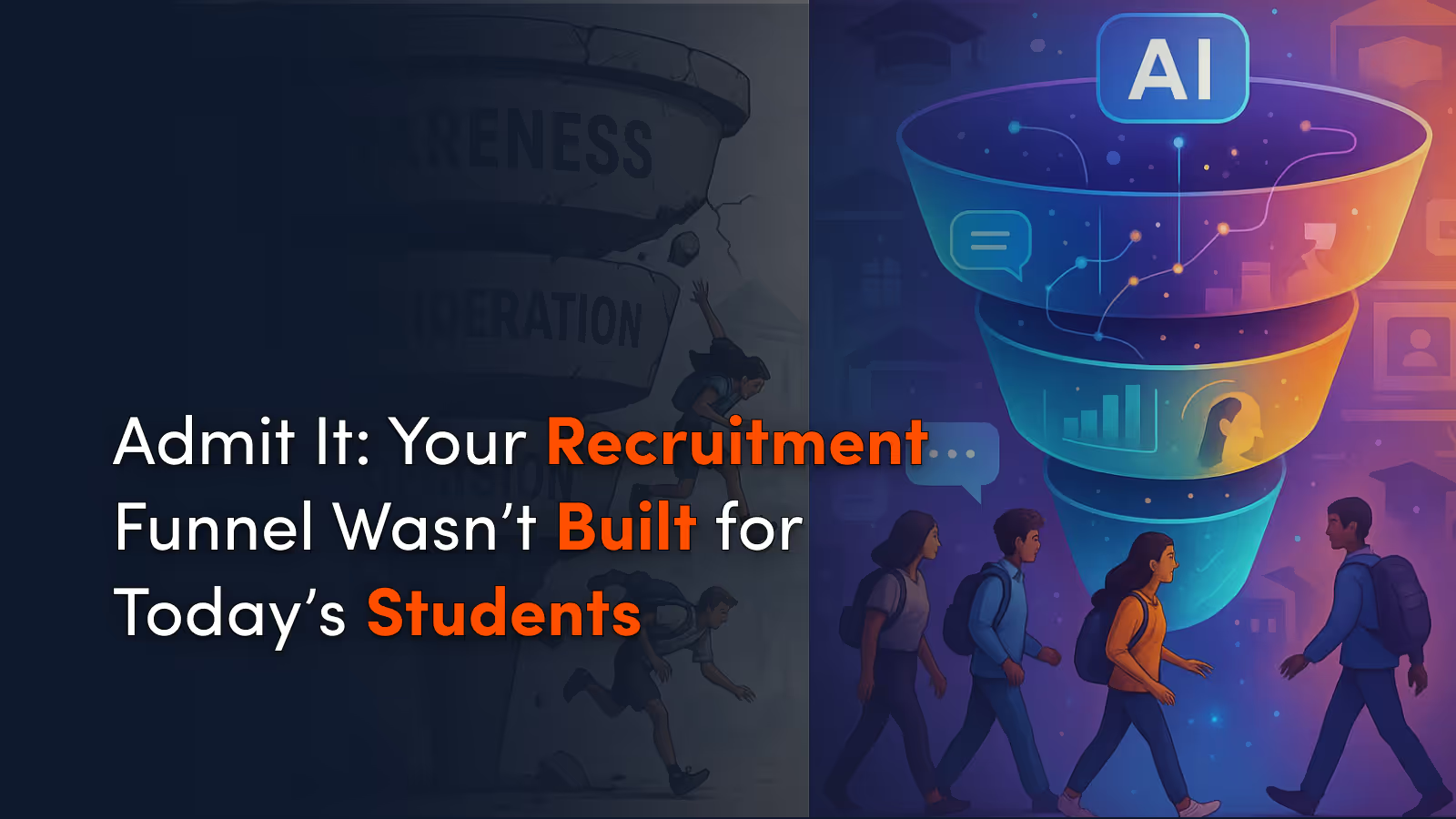About the Blog
Let’s be honest — your enrollment funnel is probably broken. Not because you’re doing it “wrong,” but because the rules you’re following were written in a different era. The traditional funnel model? It assumes a linear path from awareness to enrollment, with clean stages and predictable drop-offs. That may have worked in 2012. But in 2025, students don’t move in straight lines — they zigzag, pause, ghost, reappear, binge your content, talk to ChatGPT, and then maybe fill out your form.
The reality is, today’s students aren’t following your funnel. They’re writing their own journey — and if your marketing model doesn’t flex with them, you’ll lose them before you even knew they were interested. But here's the good news: AI is giving enrollment marketers an entirely new way to build for the behaviors of today’s prospective students. It’s time to toss the static funnel and rethink how we guide students using three AI-powered strategies that are already transforming enrollment marketing: dynamic segmentation, intent scoring, and agent-led nudges.
Smart Shifts: What’s Replacing the Traditional Funnel
- Dynamic Segmentation: AI can now re-sort your audiences in real-time based on behavior, not guesswork.
- Intent Scoring: Go beyond opens and clicks — measure what really signals “I’m ready.”
- Agent-Led Nudges: Use AI assistants to deliver timely, personalized outreach at scale.
- Predictive Engagement: Know who to talk to, when, and how — before they raise their hand.
- Real-Time Optimization: Funnels that adapt based on student behavior, not quarterly reports.
Static Funnels Don’t Work in a Real-Time World
The classic funnel model is a relic of a simpler time. It assumes prospective students move from awareness to interest to consideration to enrollment in neat, measurable steps. But today’s digital-first students don’t follow a set path. They hop in and out of your content, explore multiple schools simultaneously, and delay decisions based on everything from finances to family input. The traditional funnel doesn’t account for this level of unpredictability — and it certainly doesn’t personalize the experience.
What’s more, legacy funnels tend to treat all prospective students the same. Once someone fills out an inquiry form, they’re thrown into a drip campaign that’s identical to every other student in that “stage.” But what if the student is further along than you think? Or just browsing? Or not even interested in the program you're promoting? Without real-time data and flexible targeting, you're probably sending the wrong message at the wrong time.
If we want to meet students where they actually are — and not where we hope they are — we need a new model. Enter AI-powered marketing funnels: flexible, intelligent systems that shift based on real-time behavior and intent.
What Is Dynamic Segmentation — and Why Should You Care?
Dynamic segmentation means your audiences aren’t set in stone — they evolve based on real-time actions. Think of it like Spotify for student journeys. Instead of building static lists (“seniors interested in business”), AI analyzes what people actually do — which emails they click, what pages they view, how often they return — and continuously reshapes your segments to reflect those behaviors.
This changes the game. You no longer have to wait for a student to fill out a form to know what they're interested in. If someone visits your nursing program page five times in one week, why are they still lumped into a general list? With dynamic segmentation, your messaging adapts in real time to what each prospect is showing you through their actions.
The result? More relevant emails, more effective ads, and a more personalized journey — all without the constant spreadsheet gymnastics that most marketing teams are stuck doing manually.
Intent Scoring: A Smarter Way to Prioritize Outreach
Intent scoring takes traditional lead scoring and gives it a serious upgrade. Instead of assigning arbitrary points for email opens or form fills, AI looks at patterns — frequency, depth of engagement, content type — to predict how close someone is to taking action. It's not just what they do, it's how and when they do it.
This helps your team focus energy where it matters. Instead of blasting everyone with the same message, you can prioritize students who are signaling high intent — and tailor your follow-up accordingly. Maybe it's a personal message from an admissions rep, maybe it's a targeted ad with next steps, maybe it’s a one-click calendar booking link.
When you understand student intent, you can stop guessing and start guiding.
Agent-Led Nudges: Scaling Personalization with AI
Imagine if every student had their own personal admissions assistant — one who could answer questions, send reminders, and suggest next steps 24/7. With AI-powered nudges, that vision is now a reality. These virtual agents don’t replace your team — they amplify it, delivering the right nudge at the right moment to keep students moving forward.
These nudges aren’t just bots replying with canned messages. They can be trained on your institution’s voice, content, and goals, and can personalize interactions based on where a student is in their journey. Whether it’s nudging a prospect to finish an application or suggesting a relevant event to someone who’s shown interest, agent-led nudges make the student journey smoother and more human.
It’s not about doing more. It’s about doing smarter and creating moments of connection that feel personal, not programmatic.
Your Funnel Doesn’t Need a Refresh. It Needs a Rebuild.
Let’s call it what it is: the traditional funnel is dead. Students aren’t following a fixed journey anymore — and it’s time we stopped trying to force them into one. The future of enrollment marketing is dynamic, responsive, and personalized, powered by AI tools that help you understand, predict, and guide behavior in real time.










